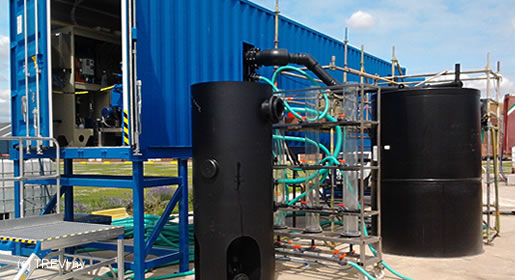Purpose
Metal removal: the removal of zinc, nickel, lead, copper, zirconium, molybdenum, ...
Fluoride removal
Removal of colloidal substances
Principle
Fine suspended solids and colloidal pollutants are stable in water and settle, at best, only very slowly. A clarifier or lamella separator is not sufficient to separate them from the waste water. The coagulation-flocculation process overcomes this problem by forming well separable flocks from this fine particulate matter. The process consists of three steps, namely coagulation, neutralisation and flocculation.
Adding a coagulant such as iron trichloride (FeCl3) or aluminiumsulphate (AlSO4) to wastewater neutralises the surface charge of fine particles and helps them clog together to form small flocks.
The coagulation process works optimally at a neutral pH. To realise this a neutralisation step is often needed after the coagulation step.
A last step is the enlargement of the flocks by dosing a polymer. Afterwards the flocks are separated from the purified water by settling or flotation.
Scheme
Applications
There are lots of applications for the coagulation flocculation process. A few examples:
The preparation of processwater and drinking water from surface water.
The physicochemical treatment of waste water. This often goes together with phosphorus removal and/or the removal of metals. Typical industries:
Automotive industry, surface treatment of metals
Storage of scrap metal or raw materials
Pretreatment of waste water which contains high concentrations of fats or suspended solids, preceding a biological waste water treatment plant. Among which:
Tankcleaning, waste processing
Food industries (slaughterhouses, meat processing, dairy, baking, oils,…)
…
Example of a realisation

Mobile physico-chemical WWTP
Operational costs
Besides the investment in the purification equipment there are also operational costs during the physicochemical removal of heavy metals from waste water. The main operational costs in this case are the consumption of chemicals and the removal of the physicochemical sludge.
Approach Trevi
Trevi always checks whether the costs for physicochemical wastewater treatment could be optimized by at-source measures or by side-stream treatment of certain wastewaters. The most efficient choice and dose of chemicals is determined based on jar tests, keeping a minimal chemicals consumption and sludge production in mind.
.jpg)